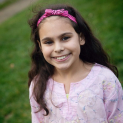
In October, Alex's Lemonade Stand Foundation hosted its third annual Young Investigators Summit, generously sponsored by Northwestern Mutual. Nearly 50 young scientists who have received ALSF grants attended, shared research, networked and collaborated. This two-day summit is one of the ways ALSF helps spur advances toward cures. These young scientists each presented their research, heard presentations from established researchers and were inspired by the story of a childhood cancer hero. The end of the conference resulted in many new professional connections, inspiration and dedication to cutting edge research for all types of childhood cancers.
We know the way we will find cures for all children is through comprehensive, innovative, creative and long-term scientific research. We also know that we will fund that research with the help of our supporters, one cup at time! Understanding the highly specialized and technical details of childhood cancer research can be a challenge for the non-scientist. We compiled a list of five things you need to know about childhood cancer research and our dedication to find cures, one cup at a time.
- Childhood cancer is fundamentally different than adult cancers. There are dozens of different types of childhood cancer, each requiring their own unique research projects. Childhood cancer is not one disease, but several. It is also not adult cancer in little bodies. Targeted, specific research into all types of childhood cancer is needed to find less harmful treatments and cures.
- Attracting and retaining bright, young researchers is critical to the future of childhood cancer research. This is why our Early Career Research grants program is so critical. Pediatric oncology research and breakthroughs can take years of dedicated research. By funding young researchers, early in their careers, we can attract the best minds ot the field, engage them in promising studies and ensure consistent, long-term projects that result in real breakthroughs.
- Innovation is critical to researching and attacking childhood cancer. The most innovative research projects do not always receive funding by the National Institutes of Health, but they can be critical and sometimes, the closest to cures. Dr. Matthias Gromeier’s innovative research on using the poliovirus to kill cancer cells in patients with glioma was initially began in 1996 and was funded by ALSF in 2006. Now, Dr. Gromeier’s work is showing amazing results for patients battling glioblastoma.
- Researching quality care, long-term outcomes and survivor success is important too. Nursing care grants allow frontline nurses to research quality of care and quality of life outcomes for their patients. Psychosocial research reveals the long term side effects of childhood cancer and treatment, giving caregivers a better understanding of the long-term needs of survivors.
- The cost of childhood cancer research is high; but every donation, no matter how big or how small adds up to weeks and months and years of research. For $50, you can fund an hour of research; $400 funds an entire day; and $2,000 funds a week. Together, we are funding research and we will have cures, one hypothesis at a time.

